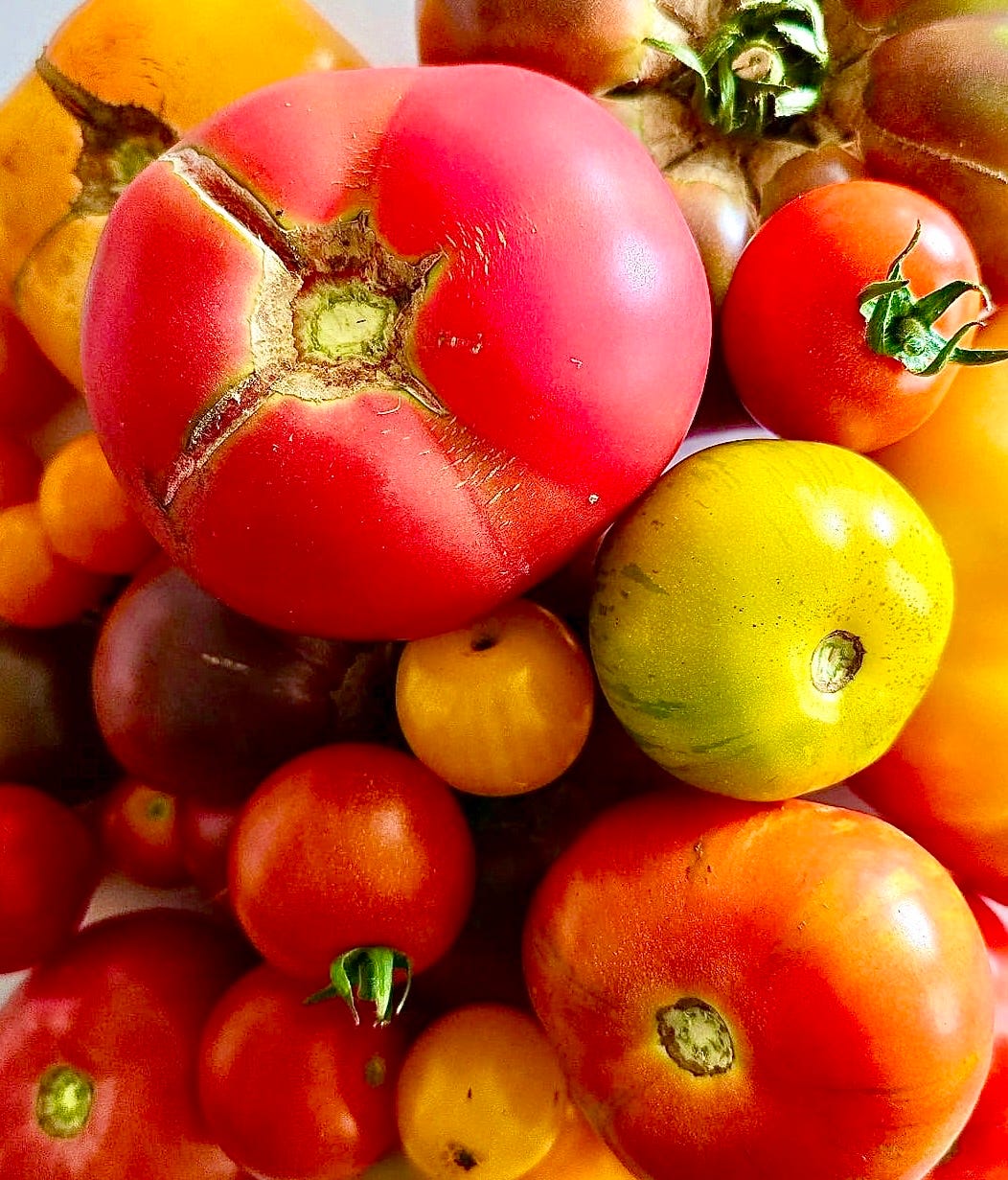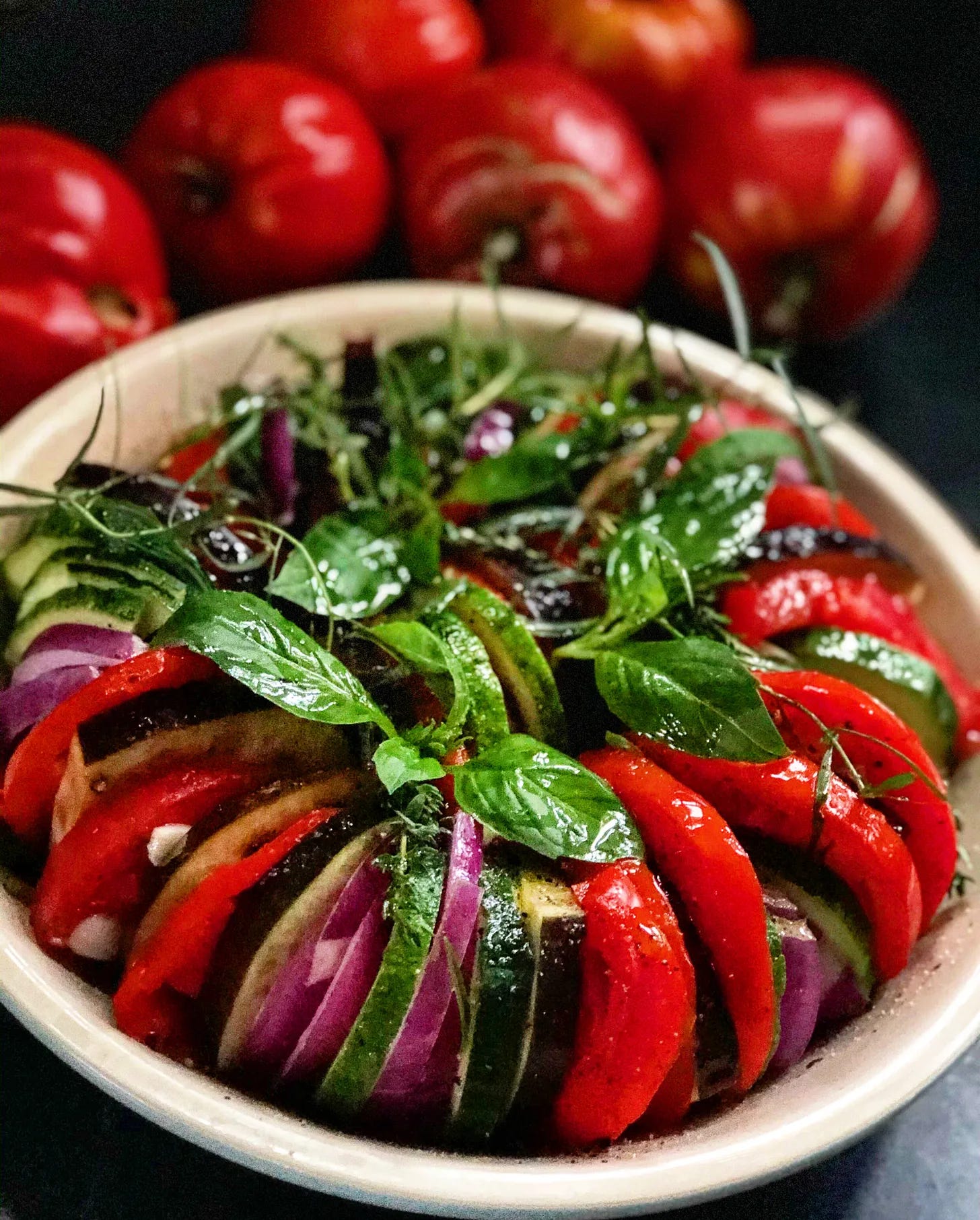August is a month of contradictions.
Never more so than in this year of unseasonably cool days offset with blazing and torrential rain tempered by cloudless skies. Still, there’s a certain whisper of autumn in the evening air that sends a little chill up my spine as I struggle to devour every bit of this late summer harvest.
Among these treasures, one claims my heart and stands out above all others in all its vibrant, sun-kissed glory: the tomato.
Tomatoes are the unsung heroes of countless dishes, either taking center stage or playing a vital supporting role. Often mistaken for a vegetable due to their culinary versatility, tomatoes are technically a fruit. Their vibrant hues, deep flavours, and astonishing variety have carried them from the hands of ancient Aztec farmers to their indispensable place in today’s kitchens—despite their bumpy start.
A sheep in wolf’s clothing
The tomato’s journey began in the lower Andes, where the Aztecs first cultivated it, calling it "tomatl" or "swollen fruit." It was the Spanish conquistadors who later brought the novelty to Europe and christened it tomato. Alongside other New World treasures like maize, potatoes, and chilies, the tomato found its way to Spain in the early 16th century, courtesy of Columbus' voyages.
Yet it wasn’t all smooth sailing for the tomato. Before becoming an essential ingredient in cuisines as diverse as Italian, Mexican, Southeast Asian, West African and Spanish, the tomato was once feared as a poisonous fruit in parts of Europe, particularly among the upper classes. This misconception stemmed from several factors: botanical confusion, a bit of bad luck, and plain unfamiliarity.
A member of the Solanaceae, or nightshade family, the tomato shares its lineage with some rather sinister cousins—like the deadly nightshade and the hallucinogenic mandrake. Early European botanists, unfamiliar with this New World import, were quick to draw connections between the tomato and its toxic relatives. The result? A ingredient viewed with deep suspicion.
Add to that a series of unfortunate coincidences. It was common practice for16th and 17th-century European nobility to dine on pewter plates laced with lead. Tomatoes, with their high acidity, caused the lead to leach from the plates into the food, resulting in what we now know as lead poisoning. Symptoms were severe, and often fatal. Naturally, the blame fell on the tomato.
Love apple
The tomato is a living, sun-kissed treasure, with the warmth of a thousand suns in its flesh.
—Jean-Baptiste Chassignet, French poet
Despite these early fears, tomatoes eventually found their way into the heart of European cuisine, particularly in Mediterranean countries like Italy and Spain. Seville, a bustling hub of international trade, likely served as the tomato’s first European port of call. By 1544, the tomato had made its Italian debut, thanks to herbalist Pietro Andrea Mattioli, who introduced it under the name "mala aurea." It later became known as "pomodoro," or "golden apple."
In France, the tomato was rumoured to have aphrodisiac qualities and earned the nickname "pomme d’amour" or "love apple.” As people began to experiment with this versatile fruit, the myths of its toxicity faded, and its culinary potential was fully realized.
Bound for glory
The best way to respect ingredients like tomatoes is to treat them simply, to respect their natural flavor and let them speak for themselves.
—Massimo Bottura, Italian chef
There’s time enough later in the year for slow simmered sauces and rich tomato-laced stews. As you relish the humble tomato now, let it shine. Keep it simple, let it be the star, and savour the rich, sun-drenched flavour that only a ripe, in-season tomato can offer.
As for me, I’ll be celebrating the tomato in all its glory, whether in a simple salad, a messy toasted tomato sandwich or simply sliced with a drizzle of olive oil and plenty of salt. If you’re lucky enough to bite into a sun-warmed tomato straight from the vine, you’re tasting not just the season, but a piece of history too.
Five favourite tomato recipes
To my way of thinking, the tomato is, without a doubt, the taste of summer. While there are infinite ways to prepare this summer treat, I go back over and over again to a few favorites.
Although it’s hard to choose just a few, here are some from the archives, with the added bonus that they also feature other summer darlings, such as peaches, melons, eggplants and zucchini. Make them now. Time is fleeting.
(PS. You can always search the Delicious Bits archive for more recipes featuring the fabulous tomato, plus a full repertoire of all the recipes I’ve written about these past four years).
Tomato soup with arugula, croutons and Pecorino
This is it: my hands-down number one favourite summer tomato recipe. It may seem funny to recommend a soup recipe in the height of summer, but that’s when tomatoes are at their magical best. With little else but tomatoes, and a few flavourful finishing touches, this is the perfect dish to make on a Friday afternoon or any time you might have 30 minutes—it’s that easy. Best of all it can be served cold, room temperature or hot. Make multiple batches and have a taste of summer in the middle of winter’s chill.
Burrata Caprese salad with peaches, tomatoes and basil drizzle
With both tomatoes and peaches at peak perfection, break away from the usual Caprese salad and try this one with peaches, tomatoes and a delightful basil drizzle from Melissa Clark.
Poached halibut with tomato-olive sauce
Tomatoes aren’t all summer salad and toasted sandwiches. When I have an abundance of cherry tomatoes bursting with flavour, I turn to this delicious and quick recipe for tomato-olive sauce that’s perfect to poach halibut in, and has dinner on the table in less than an hour.
My favourite way with leftover bread is panzanella salad. Summer’s abundance is the perfect juicy foil to the chunks of stale bread tossed with a simple vinaigrette. While the classic version uses primarily tomatoes, stale bread, red onions and basil, this version from Alon Shaya has the addition of ripe juicy peaches, plus tarragon, mint and sumac that takes this dish to the next level.
Provençal summer vegetable tian
Like any regional dish, Provençal vegetable tian has many variations on a central theme. What is true of any great Provençal tian is plenty of late summer produce, most notably tomatoes, zucchini and eggplant; lots of herbs; a decided note of garlic; and plenty of good olive oil to finish.











Great post! I loved the history lesson and agree that tomatoes play such a pivotal role in our cooking! I have bushel of tomatoes that are growing in my garden. You’ve inspired me to use them in different ways than I usually do!